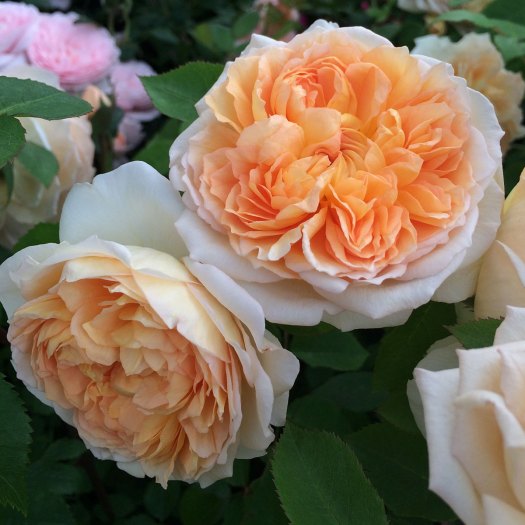
My sweetheart uses the term ‘mannerly climber’ to describe a rose that will climb rather than swamp any structure provided for it by human carers: if the rose produces a succession of elegant, petal-packed rosettes, that’s so much more courteous of it. Rosa ‘Bathsheba’ is a fine example of a mannerly climbing rose.
Pictures rarely tell the full tale of any plant, particularly not a rose. We miss out on the fragrance (strong, flowery myrrh, since you ask) and find it hard to judge the size of the flowers. These are large ones, with a hint of a button eye that becomes Bathsheba very well.

As you’ll see here, the rich apricot colour gradually softens and yellows as the flower matures.
A trellis, wall, tall fence, obelisk or pillar will display Rosa ‘Bathsheba’ to its best advantage.
Part of the preparation for any flower show is to produce neat labels – the judges have been known to deduct marks if some are missing, or so the rumour goes. I try to remember to take a picture of the label as well as the plant, but rarely share them.

I’ve often wondered whether everyone would understand that ‘Clg’ after a rose name means that the rose is a climber. Perhaps it is self-explanatory.
Every protected plant has a code-type appellation – the legal plant name. Being familiar with the minefield that is rose naming, from its earliest days, my website has carried a blanket statement to record that many plants are protected by patents and/or trademarks and to refer all questions about protection of specific varieties to the breeder’s websites.
Most gardeners ignore the appellation but by doing so, they’re sometimes missing a secret, hidden in plain sight. It’s not just a reliable way to identify the breeder: some English Roses have quirky appellations that will raise a smile of recognition or a groan.
Austin roses always start with Aus, a short code for the breeder. The appellation for Rosa ‘Bathsheba’ is Auschimbley, the second half of the code ‘chimbley’ suggesting that Bathsheba has always showed a propensity to climb, or grow like a chimney, chimbley being a dialect form of the word.
Other character-type appellations include Aushedge (R. ‘Wild Edric’), Austough (R. ‘Rosemoor’), Ausglobe (R. ‘Brother Cadfael’ has globe shaped flowers) and Aussemi (R. ‘The Herbalist’ is a semi-double).

So far so good: what’s the secret? Groan-inducing appellations include Auswife (R. ‘The Wife Of Bath’ – housewife); Ausencart (R. Benjamin Britten’ – horse and cart); Auschestnut (R. ‘St. Alban’); Ausky (R.’Mistress Quickly’); Auspishus (R. ‘Janet’), etc.
There is even an Ausufo (R. ‘Comtes de Champagne’).

Gorgeous rose – and thanks for the explanation regarding rose naming, you learn something new every day!
My pleasure!
Thank you for opening my eyes to the coded appellations for Austin roses. Think of the possibilities: Austracized, Austerity, Auspices, and my favorite – Austentatious!
You seem the perfect fit for the Licensing Department 🙂
The rules of nomenclature we learned in school are not the same anymore. With so many other species, the species names are omitted. Because of all the crazy breeding, for some, the species are unknown.
You’re right, with today’s intensive breeding programmes lasting many years, and making hundreds of thousands of crosses annually, it’s a numbers game and the species involved become a moot point.
That is part of the reason I prefer the classics.